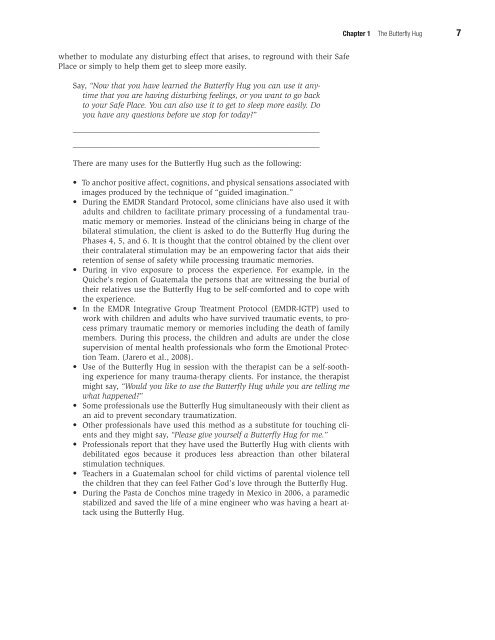(EMDR) Scripted - Springer Publishing
(EMDR) Scripted - Springer Publishing
(EMDR) Scripted - Springer Publishing
You also want an ePaper? Increase the reach of your titles
YUMPU automatically turns print PDFs into web optimized ePapers that Google loves.
Chapter 1 The Butterfl y Hug 7<br />
whether to modulate any disturbing effect that arises, to reground with their Safe<br />
Place or simply to help them get to sleep more easily.<br />
Say, “Now that you have learned the Butterfly Hug you can use it anytime<br />
that you are having disturbing feelings, or you want to go back<br />
to your Safe Place. You can also use it to get to sleep more easily. Do<br />
you have any questions before we stop for today?”<br />
_____________________________________________________________<br />
_____________________________________________________________<br />
There are many uses for the Butterfly Hug such as the following:<br />
• To anchor positive affect, cognitions, and physical sensations associated with<br />
images produced by the technique of “guided imagination.”<br />
• During the <strong>EMDR</strong> Standard Protocol, some clinicians have also used it with<br />
adults and children to facilitate primary processing of a fundamental traumatic<br />
memory or memories. Instead of the clinicians being in charge of the<br />
bilateral stimulation, the client is asked to do the Butterfly Hug during the<br />
Phases 4, 5, and 6. It is thought that the control obtained by the client over<br />
their contralateral stimulation may be an empowering factor that aids their<br />
retention of sense of safety while processing traumatic memories.<br />
• During in vivo exposure to process the experience. For example, in the<br />
Quiche’s region of Guatemala the persons that are witnessing the burial of<br />
their relatives use the Butterfly Hug to be self-comforted and to cope with<br />
the experience.<br />
• In the <strong>EMDR</strong> Integrative Group Treatment Protocol (<strong>EMDR</strong>-IGTP) used to<br />
work with children and adults who have survived traumatic events, to process<br />
primary traumatic memory or memories including the death of family<br />
members. During this process, the children and adults are under the close<br />
supervision of mental health professionals who form the Emotional Protection<br />
Team. (Jarero et al., 2008).<br />
• Use of the Butterfly Hug in session with the therapist can be a self-soothing<br />
experience for many trauma-therapy clients. For instance, the therapist<br />
might say, “Would you like to use the Butterfly Hug while you are telling me<br />
what happened?”<br />
• Some professionals use the Butterfly Hug simultaneously with their client as<br />
an aid to prevent secondary traumatization.<br />
• Other professionals have used this method as a substitute for touching clients<br />
and they might say, “Please give yourself a Butterfly Hug for me.”<br />
• Professionals report that they have used the Butterfly Hug with clients with<br />
debilitated egos because it produces less abreaction than other bilateral<br />
stimulation techniques.<br />
• Teachers in a Guatemalan school for child victims of parental violence tell<br />
the children that they can feel Father God’s love through the Butterfly Hug.<br />
• During the Pasta de Conchos mine tragedy in Mexico in 2006, a paramedic<br />
stabilized and saved the life of a mine engineer who was having a heart attack<br />
using the Butterfly Hug.

















